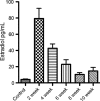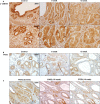An estrogen-induced endometrial hyperplasia mouse model recapitulating human disease progression and genetic aberrations
- PMID: 25809780
- PMCID: PMC4529342
- DOI: 10.1002/cam4.445
An estrogen-induced endometrial hyperplasia mouse model recapitulating human disease progression and genetic aberrations
Abstract
Endometrial hyperplasia (EH) is a condition originating from uterine endometrial glands undergoing disordered proliferation including the risk to progress to endometrial adenocarcinoma. In recent years, a steady increase in EH cases among younger women of reproductive age accentuates the demand of therapeutic alternatives, which emphasizes that an improved disease model for therapeutic agents evaluation is concurrently desired. Here, a new hormone-induced EH mouse model was developed using a subcutaneous estradiol (E2)-sustained releasing pellet, which elevates the serum E2 level in mice, closely mimicking the effect known as estrogen dominance with underlying, pathological E2 levels in patients. The onset and progression of EH generated within this model recapitulate a clinically relevant, pathological transformation, beginning with disordered proliferation developing to simple EH, advancing to atypical EH, and then progressing to precancerous stages, all following a chronologic manner. Although a general increase in nuclear progesterone receptor (PR) expression occurred after E2 expression, a total loss in PR was noted in some endometrial glands as disease advanced to simple EH. Furthermore, estrogen receptor (ER) expression in the nucleus of endometrial cells was reduced in disordered proliferation and increased when EH progressed to atypical EH and precancerous stages. This EH model also resembles other pathological patterns found in human disease such as leukocytic infiltration, genetic aberrations in β-catenin, and joint phosphatase and tensin homolog/paired box gene 2 (PTEN/PAX2) silencing. In summary, this new and comprehensively characterized EH model is cost-effective, easily reproducible, and may serve as a tool for preclinical testing of therapeutic agents and facilitate further investigation of EH.
Keywords: Endometrial cancer; endometrial hyperplasia; estrogen; mouse model.
© 2015 The Authors. Cancer Medicine published by John Wiley & Sons Ltd.
Figures






Similar articles
-
Endometrial hyperplasia-related inflammation: its role in the development and progression of endometrial hyperplasia.Inflamm Res. 2016 Oct;65(10):785-94. doi: 10.1007/s00011-016-0960-z. Epub 2016 Jun 16. Inflamm Res. 2016. PMID: 27312112
-
Analysis of PTEN, estrogen receptor α and progesterone receptor expression in endometrial hyperplasia using tissue microarray.Pol J Pathol. 2011 Sep;62(3):133-8. Pol J Pathol. 2011. PMID: 22102068
-
Should progesterone and estrogen receptors be assessed for predicting the response to conservative treatment of endometrial hyperplasia and cancer? A systematic review and meta-analysis.Acta Obstet Gynecol Scand. 2019 Aug;98(8):976-987. doi: 10.1111/aogs.13586. Epub 2019 Mar 28. Acta Obstet Gynecol Scand. 2019. PMID: 30779338
-
IMMUNOHISTOCHEMISTRY IN ENDOMETRIAL HYPERPLASIA AND ENDOMETRIAL ADENOCARCINOMA.Rev Med Chir Soc Med Nat Iasi. 2016 Apr-Jun;120(2):355-62. Rev Med Chir Soc Med Nat Iasi. 2016. PMID: 27483717
-
Therapeutic options for management of endometrial hyperplasia.J Gynecol Oncol. 2016 Jan;27(1):e8. doi: 10.3802/jgo.2016.27.e8. Epub 2015 Dec 1. J Gynecol Oncol. 2016. PMID: 26463434 Free PMC article. Review.
Cited by
-
DNA methylation promotes paired box 2 expression via myeloid zinc finger 1 in endometrial cancer.Oncotarget. 2016 Dec 20;7(51):84785-84797. doi: 10.18632/oncotarget.12626. Oncotarget. 2016. PMID: 27764784 Free PMC article.
-
Molecular characterization of Wdr13 knockout female mice uteri: a model for human endometrial hyperplasia.Sci Rep. 2020 Sep 3;10(1):14621. doi: 10.1038/s41598-020-70773-w. Sci Rep. 2020. PMID: 32883989 Free PMC article.
-
Estrogen Signaling in Endometrial Cancer: a Key Oncogenic Pathway with Several Open Questions.Horm Cancer. 2019 Jun;10(2-3):51-63. doi: 10.1007/s12672-019-0358-9. Epub 2019 Feb 2. Horm Cancer. 2019. PMID: 30712080 Free PMC article. Review.
-
What maintains the high intra-follicular estradiol concentration in pre-ovulatory follicles?J Assist Reprod Genet. 2016 Jan;33(1):85-94. doi: 10.1007/s10815-015-0612-1. Epub 2015 Nov 9. J Assist Reprod Genet. 2016. PMID: 26552664 Free PMC article.
-
Bisphenol S Increases Cell Number and Stimulates Migration of Endometrial Epithelial Cells.J ASEAN Fed Endocr Soc. 2023;38(1):13-22. doi: 10.15605/jafes.037.S7. Epub 2022 Aug 6. J ASEAN Fed Endocr Soc. 2023. PMID: 37234927 Free PMC article.
References
-
- Siegel R, Ma J, Zou Z. Jemal A. Cancer statistics, 2014. CA Cancer J. Clin. 2014;64:9–29. - PubMed
-
- Lacey JV. Chia VM. Endometrial hyperplasia and the risk of progression to carcinoma. Maturitas. 2009;63:39–44. - PubMed
-
- Schlaen I, Bocanera R. Figueroa-Casas P. Endometrial cancer and its precursors: a comparison of histological and clinical features. Maturitas. 1986;8:335–44. - PubMed
-
- Kirschner MA, Schneider G, Ertel NH. Worton E. Obesity, androgens, estrogens, and cancer risk. Cancer Res. 1982;42(Suppl. 8):3281s–3285s. - PubMed
Publication types
MeSH terms
Substances
LinkOut - more resources
Full Text Sources
Other Literature Sources
Research Materials

